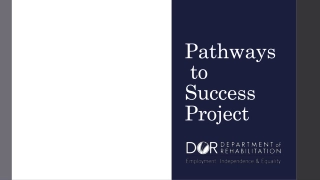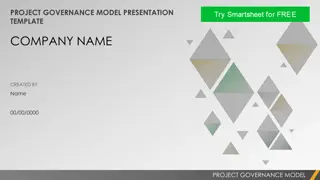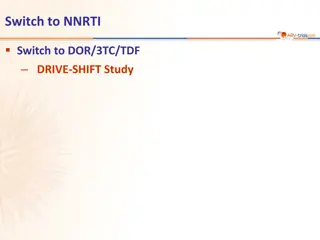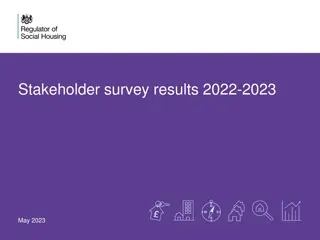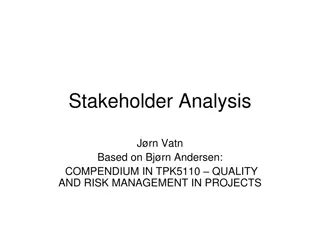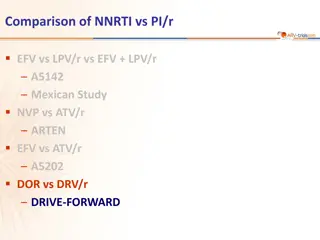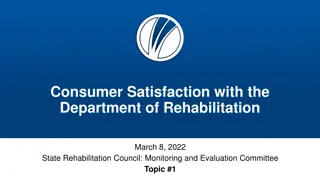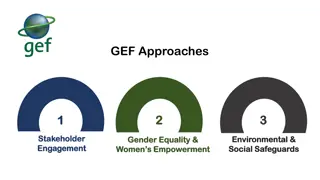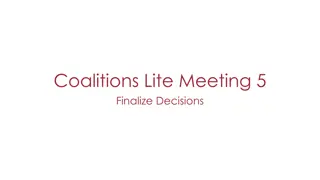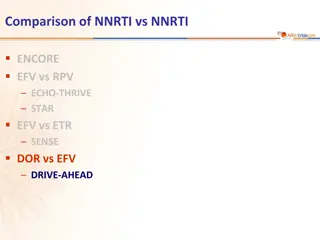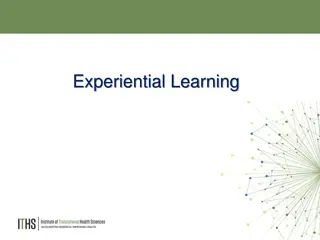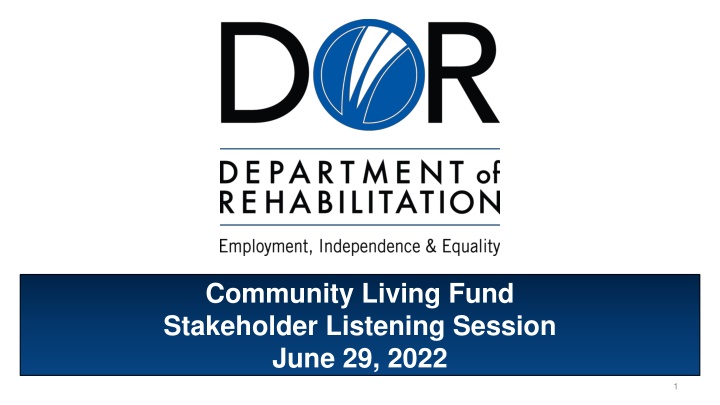
Stakeholder Listening Session for Community Living Fund - June 29, 2022
Join the Stakeholder Listening Session on June 29, 2022, for the Community Living Fund. Learn about transition initiatives, program details, and considerations for implementation. Participate in discussions surrounding employment, independence, and equality for individuals with disabilities. Engage with key stakeholders and contribute to the mission of providing services and advocacy for a more inclusive society.
Uploaded on | 1 Views
Download Presentation

Please find below an Image/Link to download the presentation.
The content on the website is provided AS IS for your information and personal use only. It may not be sold, licensed, or shared on other websites without obtaining consent from the author. If you encounter any issues during the download, it is possible that the publisher has removed the file from their server.
You are allowed to download the files provided on this website for personal or commercial use, subject to the condition that they are used lawfully. All files are the property of their respective owners.
The content on the website is provided AS IS for your information and personal use only. It may not be sold, licensed, or shared on other websites without obtaining consent from the author.
E N D
Presentation Transcript
Community Living Fund Stakeholder Listening Session June 29, 2022 1
HOUSEKEEPING This meeting is being recorded. If you are not speaking, please mute yourself. To mute, you can select the icon of a microphone on the meeting toolbar on the bottom of your screen or use Alt+A. For Jaws users to turn off chat, hit insert, then the space bar + S. If you want to speak or ask a question, please use the raise your hand feature by clicking on the reactions button on the meeting toolbar and choose raise hand. The shortcut key to raise your hand is Alt+Y.
HOUSEKEEPING To see the captions, please select the three dots on the meeting toolbar and select Live Transcript show subtitle option. Please use the chat function only to request assistance, provide public comment, or ask questions. Chat is not accessible to everyone and can be distracting. There will be time for public comment later in the meeting. If anyone is having issues with hearing or seeing the meeting, please send a private message or email to Cynthia Butler, Cynthia.butler@dor.ca.gov.
WELCOME & INTRODUCTIONS Kim Rutledge Deputy Director of Legislation and Communications, Department of Rehabilitation Sarah Steenhausen Deputy Director of Aging Policy, Research and Equity, Department of Aging
WELCOME & INTRODUCTIONS Community Living Fund Agenda 1. Community Living Transition and Diversion Initiatives 2. Program Overview 3. Program Details 4. Considerations for Implementation Public comment 5. Next steps
VISION AND MISSION DOR Vision: Employment, Independence and Equality for all Californians with Disabilities. DOR Mission: The California Department of Rehabilitation (DOR) works in partnership with consumers and other stakeholders to provide services and advocacy resulting in employment, independent living and equality for individuals with disabilities.
COMMUNITY LIVING FUND Americans with Disabilities Act Federal landmark civil rights legislation prohibited the discrimination against individuals with disabilities in all areas of public life U.S. Supreme Court Olmstead Decision Ruled that segregation of individuals with disabilities is unlawful Requires states to ensure access to services and supports in the community as an alternative to institutionalization
COMMUNITY LIVING FUND Advance California for All Ages through the Master Plan for Aging by 2030 5 Bold Goals for 2030 Goal 1: Housing for All Ages and Stages Goal 2: Health Reimagined Goal 3: Inclusion and Equity, Not Isolation Goal 4: Caregiving the Works Goal 5: Affording Aging
COMMUNITY LIVING FUND Master Plan for Aging Goals and strategies include community living and transition and diversion Goal 2: Health Reimagined Innovative models, expand home and community-based services, Medi-Cal via CalAIM Goal 3: Inclusion and Equity, Not Isolation No Wrong Door and Aging & Disability Resource Connections
COMMUNITY LIVING FUND Master Plan for Aging Long Term Services and Supports Stakeholder Subcommittee recommendations: Remove barriers to community living Develop statewide institutional diversion and transition strategy Community Living Fund Person-centered assessments and planning California Community Transitions program Medi-Cal managed care
COMMUNITY LIVING FUND Transition and Diversion Initiatives California Community Transitions Money Follows the Person In-Home Supportive Services Home and Community Based Services Waivers CalAIM Managed Care State Plan for Independent Living Transition and Diversion Funds
COMMUNITY LIVING FUND Department of Aging has requested a General Fund increase in Fiscal Year (FY) 2022-23 and 2023-24 and ongoing to advance the Master Plan for Aging $10 million in General Fund for the Department of Rehabilitation to expand related services over three years Bridge program that expedites the provision of goods or services not available through other means to individuals either transitioning to the community or at-risk of institutionalization
Why a Community Living Fund Joe Xavier Director, Department of Rehabilitation
What is the Community Living Fund Ana Acton Deputy Director of Independent Living and Community Access, Department of Rehabilitation
COMMUNITY LIVING FUND Why a Community Living Fund? People with disabilities and older adults who are institutionalized need support to transition to community living Individuals who are at-risk of institutionalization need support to remain in the community California has 400,000 individuals residing in nursing facilities annually with some 24,000 individuals remaining in the facility for one year or longer
COMMUNITY LIVING FUND Why a Community Living Fund? Individuals with disabilities and older adults who are at-risk of going into an institutional setting Individuals often need flexible funds to assist with short- term costs Individuals need connection to long term services and supports
COMMUNITY LIVING FUND What is the Community Living Fund? Designed to expand the capacity of disability and aging organizations to provide person-centered transition and diversion services for people of all ages and with any type of disability who do not qualify for existing services Funding will be distributed to eligible disability and aging service providers with expertise in transition and diversion services Expanding services and not supplanting existing funding
COMMUNITY LIVING FUND What is the Community Living Fund? Coordination with existing systems and programs that do transition and diversion California Community Transitions In Home Supportive Services Home and Community Based Services Waivers Homeless Coordinated Entry systems Multi-Senior Services Program Assisted Living Waivers Emergency Vouchers Housing Authorities CalAIM Managed Care Aging and Disability Resource Connections Home Safe Program
COMMUNITY LIVING FUND What is Community Living? People with disabilities and older adults have the same opportunity as everyone else to: Choose where to live Earn a living Participate in society Make decisions about their lives
COMMUNITY LIVING FUND What is Transition? Assist individuals to transition into the community from one of the following types of institutional facilities: licensed skilled nursing facility, intermediate care facility for the developmentally disabled, state hospital for the mentally ill, developmental center, rehabilitation hospital, California Veterans home, or Acute Care Hospitals. Includes connection to long-term services and supports that improve social, emotional, and physical well-being of individuals
COMMUNITY LIVING FUND What is Diversion? Individuals who are at risk of being institutionalized or entering an institutional setting Individuals at risk of institutionalization often need timely access to services, supports, and equipment to prevent them from going into a higher level of care or losing their housing and formal or informal support systems Expedited access to services and supports that can be put into place until a long-term plan can be developed
COMMUNITY LIVING FUND What is eligibility for the program? Individuals at risk of going into an institutional setting or who are transitioning from an institutional setting to community living Individuals with income at or below 300% of the federal poverty level and who do not qualify for Medi-Cal and cannot afford out-of-pocket costs associated with transition and diversion Individuals who have Medi-Cal if their needs are beyond what is covered by Medi-Cal
COMMUNITY LIVING FUND What are allowable activities? Direct consumer costs: o Household necessities o Rent and utilities o Personal items o Personal assistance not covered by IHSS o Moving expenses o Assistive technology and training o Orientation and mobility training o Transportation o Occupational or physical therapists assessment Staffing costs for service coordination where no other source exists.
COMMUNITY LIVING FUND Outcome Measures Transition and diversion services to 1,360 consumers over 3 years Evaluation will include assessing impact of community living on older adults and people with disabilities and will include measures of quality of life and ability to remain in the community
Program Implementation Michael Thomas Assistant Deputy Director of Specialized Services, Department of Rehabilitation
COMMUNITY LIVING FUND How will the program be implemented? Stakeholder engagement Enter into agreements with a statewide network of eligible disability and aging service providers such as: Independent Living Centers Older Individuals Who Are Blind programs Traumatic Brain Injury programs Aging and Disability Resource Connections
COMMUNITY LIVING FUND How will the program be implemented? Provide person-centered transition and diversion services Assess individuals for needs and eligibility of services and coordinate services with other systems Document that all possible funding avenues and eligibility (including Medi-Cal) are not available
Considerations for Implementation Public Comment
COMMUNITY LIVING FUND Considerations for Implementation How can DOR support organizations to expand capacity to provide these services?
COMMUNITY LIVING FUND Considerations for Implementation Community Living Fund cannot supplant or duplicate existing services. What would you need from DOR to support you identifying the programs and services that exist? Use of this fund will require partnering with systems other than yours, how can DOR help support that partnership?
COMMUNITY LIVING FUND Considerations for Implementation Knowing eligibility is 300% of the federal poverty level or beyond what Medi-Cal can provide, is there anything else we should be considering for eligibility?
COMMUNITY LIVING FUND Considerations for Implementation We mentioned existing systems that the department connects with that provides community living services. Are there other systems we should be engaging with?
COMMUNITY LIVING FUND Considerations for Implementation We know the Community Living Fund gives us an opportunity to demonstrate the importance, need, and demand for services. How do we ensure these funds are fully utilized?
COMMUNITY LIVING FUND Considerations for Implementation What other issues should we consider with implementing this program?
COMMUNITY LIVING FUND Wrap-up Next Steps Contact for questions E-mail at ILInfo@dor.ca.gov Call DOR s Legislation & Communications Office at (916) 558-5874

